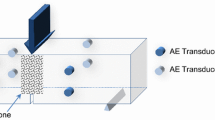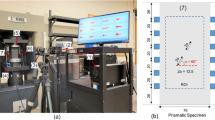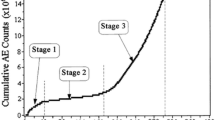Abstract
The complex process of fracture occurring in heterogeneous quasi-brittle material concrete under splitting tensile load is researched using the acoustic emission (AE) and digital imaging tools. Analyses of the AE events and energy reveal four stages of fracture under opening mode—elastic stage, growth of microcracks, stable crack growth and major crack growth until final failure. In the stable crack growth stage simultaneous microcracking and their coalescence into macrocracks take place. The dimensions and shape of the fracture process zone (FPZ) are determined through the distribution of acoustic emission events and their kernel density contours. Assuming a logistic or sigmoid law for the growth of micro and macro cracks, the b-value is seen to increase steadily reaching a constant magnitude close to failure. The growth of logistic b-value is found to follow the crack growth curve indicating its use in predicting failure.





















Similar content being viewed by others
References
Alam S, Loukili A, Grondin F, Rozière E (2015) Use of the digital image correlation and acoustic emission technique to study the effect of structural size on cracking of reinforced concrete. Eng Fract Mech 143:17–31
Bazant Z, Kazemi M (1990) Determination of fracture energy, process zone length and brittleness number from size effect, with application to rock and concrete. Int J Fract 44:111–131
Bhowmik S, Ray S (2019) An experimental approach for characterization of fracture process zone in concrete. Eng Fract Mech 211:401–419
Bhowmik S, Dubey S, Ray S (2019) Investigation on fracture processes of concrete. Frattura ed Integrità Strutturale 13:419–428
Blaber J, Adair B, Antoniou A (2015) Ncorr: open-source 2d digital image correlation matlab software. Exp Mech 55:1105–1122
Brühwiler E, Wittmann F (1990) The wedge splitting test, a new method of performing stable fracture mechanics tests. Eng Fract Mech 35:117–125
Carpinteri A, Lacidogna G, Niccolini G, Puzzi S (2008) Critical defect size distributions in concrete structures detected by the acoustic emission technique. Meccanica 43:349–363
Chen B, Liu J (2004) Experimental study on AE characteristics of three-point-bending concrete beam. Cem Concr Res 34:391–397
Chen JY, Bai WF, Fan SL, Lin G (2009) Statistical damage model for quasi-brittle materials under uniaxial tension. J Cent South Univ Technol 16:669–676
Chen C, Fan X, Chen X (2020) Experimental investigation of concrete fracture behavior with different loading rates based on acoustic emission. Constr Build Mater 237:117472
Cox SJD, Meredith PG (1993) Microcrack formation and material softening in rock measured by monitoring acoustic emissions. Int J Rock Mech Miner Sci Geomech Abstracts 30:11–24
Dai S, Liu X, Nawnit K (2019) Experimental study on the fracture process zone characteristics in concrete utilizing DIC and AE methods. Appl Sci 9:1346
Dong W, Rong H, Wu Q, Li J (2018) Investigations on the FPZ evolution of concrete after sustained loading by means of the DIC technique. Constr Build Mater 188:49–57
Dutler N, Nejati M, Valley B, Amann F, Molinari G (2018) On the link between fracture toughness, tensile strength, and fracture process zone in anisotropic rocks. Eng Fract Mech 201:56–79
Evans R, Marathe M (1968) Microcracking and stress–strain curves for concrete in tension. Matériaux et Constr 1:61–64
Hadjab H, Thimus JF, Chabaat M (2007) The use of acoustic emission to investigate fracture process zone in notched concrete beams. Curr Sci 93:648–653
Han Q, Yang G, Xu J, Fu Z, Lacidogna G, Carpinteri A (2019) Acoustic emission data analyses based on crumb rubber concrete beam bending tests. Eng Fract Mech 210:189–202
Hou YK, Duan SJ, An RM (2019) Solving the cohesive zone model analytic function for concrete based on wedge-splitting test on a compact tension specimen. Theoret Appl Fract Mech 102:162–170
Ing S, Colombo IGM, Forde MC (2003) Assessing damage of reinforced concrete beam using b-value analysis of acoustic emission signals. J Mater Civ Eng 15:280–286
Kurz JH, Finck F, Grosse CU, Reinhardt HW (2006) Stress drop and stress redistribution in concrete quantified over time by the b-value analysis. Struct Health Monit 5:69–81
Landis EN (1999) Micro–macro fracture relationships and acoustic emissions in concrete. Constr Build Mater 13:65–72
Li Y, Qing L, Cheng Y, Ma G (2020) Determining the tensile strength of concrete for wedge splitting specimens based on the fracture extreme theory. Theoret Appl Fract Mech 108:102654
Maslov LA, Chebotarev VI (2017) Modeling statistics and kinetics of the natural aggregation structures and processes with the solution of generalized logistic equation. Physica A 468:691–697
Muralidhara S, Prasad BR, Eskandari H, Karihaloo BL (2010) Fracture process zone size and true fracture energy of concrete using acoustic emission. Constr Build Mater 24:479–486
Nguyen-Tat T, Ranaivomanana N, Balayssac JP (2018) Characterization of damage in concrete beams under bending with acoustic emission technique (aet). Constr Build Mater 187:487–500
Nitin Burud B, Chandra Kishen JM (2019) Application of generalized logistic equation for b-value analysis in fracture of plain concrete beams under flexure. Eng Fract Mech 210:228–246
Ohtsu M (2010) Recommendation of RILEM TC 212-ACD: acoustic emission and related NDE techniques for crack detection and damage evaluation in concrete. Mater Struct 43:1187–1189
Otsuka K, Date H (2000) Fracture process zone in concrete tension specimen. Eng Fract Mech 65:111–131
Pan B (2009) Reliability-guided digital image correlation for image deformation measurement. Appl Opt 48:1535–1542
Pan B, Wang Z, Lu Z (2010) Genuine full-field deformation measurement of an object with complex shape using reliability-guided digital image correlation. Opt Express 18:1011–1023
Pan B, Xie H, Wang Z (2010) Equivalence of digital image correlation criteria for pattern matching. Appl Opt 49:5501–5509
Pan B, Li K, Tong W (2013) Fast, robust and accurate digital image correlation calculation without redundant computations. Exp Mech 53:1277–1289
Prashanth MH (2018) Experimental investigations into fracture and fatigue behavior of plain and reinforced concrete beams using acoustic emission technique. Ph.D. thesis. Department of Civil Engineering, Indian Institute of Science, Bangalore, India
Rao M, Lakshmi KP (2006) Amplitude distribution analysis of acoustic emissions and investigation of the development of brittle fracture in rock. Indian J Pure Appl Phys 44:820–825
Rodríguez P, Celestino TB (2019) Application of acoustic emission monitoring and signal analysis to the qualitative and quantitative characterization of the fracturing process in rocks. Eng Fract Mech 210:54–69
Sagar RV, Prasad R, Prasad BR, Rao M (2013) Microcracking and fracture process in cement mortar and concrete: a comparative study using acoustic emission technique. Exp Mech 53:1161–1175
Saliba J, Loukili A, Regoin JP, Grégoire D, Verdon L, Pijaudier-Cabot G (2015) Experimental analysis of crack evolution in concrete by the acoustic emission technique. Frattura ed Integrità Strutturale 9:1–7
Saucedo L, Rena CY, Ruiz G (2012) Fully-developed FPZ length in quasi-brittle materials. Int J Fract 178:97–112
Schreier HW, Braasch JR, Sutton MA (2000) Systematic errors in digital image correlation caused by intensity interpolation. OptEn 39:2915–2921
Wittmann F (2002) Crack formation and fracture energy of normal and high strength concrete. Sadhana 27:413–423
Xiao J, Schneider H, Dönnecke C, König G (2004) Wedge splitting test on fracture behaviour of ultra high strength concrete. Constr Build Mater 18:359–365
Zhang G, Li H, Wang M, Li X, Wang Z, Deng S (2019) Crack-induced acoustic emission and anisotropy variation of brittle rocks containing natural fractures. J Geophys Eng 16:599–610
Zhou XP, Zhang JZ, Berto F (2020) Fracture analysis in brittle sandstone by digital imaging and AE techniques: role of flaw length ratio. J Mater Civil Eng 32:04020085
Author information
Authors and Affiliations
Corresponding author
Ethics declarations
Conflict of interest
The authors declare that they have no known competing financial interests or personal relationships that could have appeared to influence the work reported in this paper.
Additional information
Publisher's Note
Springer Nature remains neutral with regard to jurisdictional claims in published maps and institutional affiliations.
Rights and permissions
Springer Nature or its licensor (e.g. a society or other partner) holds exclusive rights to this article under a publishing agreement with the author(s) or other rightsholder(s); author self-archiving of the accepted manuscript version of this article is solely governed by the terms of such publishing agreement and applicable law.
About this article
Cite this article
Singh, P., Yogesh, R., Bhowmik, S. et al. Insights into the fracturing process of plain concrete under crack opening. Int J Fract 241, 153–170 (2023). https://doi.org/10.1007/s10704-023-00692-0
Received:
Accepted:
Published:
Issue Date:
DOI: https://doi.org/10.1007/s10704-023-00692-0




